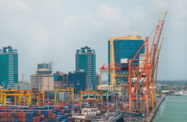State initiatives to boost Trinidad and Tobago’s maritime services and logistics sectors are expected to broaden the country’s economic base and boost government coffers.
Policies focusing on T&T’s maritime sector have been given greater urgency amid the recent opening of the Panama Canal expansion, with companies operating in the lifecycle repairs and maintenance (LCM) and bunkering segments already looking to invest to increase capacity.
Room for growth
In mid-June Paula Gopee-Scoon, minister of trade and industry, announced the government would sharpen its focus on developing various segments of the maritime industry, a strategy she said would capitalise on T&T’s strengths.
“These advantages include this country’s geographic location, growing trade links with neighbouring countries, healthy export base, highly educated and diverse work force, vibrant energy sector and low fuel rates,” Gopee-Scoon said at a press conference in June.
To lead this initiative, the government has established a standing committee chaired by Franklin Khan, the minister of rural development and local government, to oversee policy development for the maritime sector.
Included in the committee’s remit are further developing the maritime sector by facilitating credit for the industry, fast tracking regulatory approvals, and promoting incentives and investment opportunities.
Following the committee’s first meeting at the end of June, Khan said it was necessary to reduce T&T’s reliance on hydrocarbons, as low oil prices can no longer sustain the country’s budgetary requirements.
“If maritime is one of the key sectors to manage the country’s budget deficit, then we must start bringing projects on-stream to have the impact that we want,” he said. “We must begin to think about a post-energy Trinidad and Tobago.”
Powered by Panama
One of the factors energising T&T’s programme to reinforce its maritime services sector is the opening of the Panama Canal expansion project at the end of June.
The upgraded canal, which saw its ship handling capacity greatly expanded, is expected to see cargo movements increase from 300m tonnes annually to 500m tonnes by 2025, according to Panamanian authorities.
While T&T’s infrastructure and location furthest south-east in the Caribbean makes the country less attractive as a trans-shipment hub for US-Caribbean trade or East-West trade through the canal, the country is in a prime position to benefit from increasing trade between the east coast of South America and the US.
Since July 2012 Oldendorff Carriers T&T (OCTTL) has operated two floating cranes at the country’s iron ore offshore trans-shipment platform. By July 2015 OCTTL had successfully shipped roughly 6m tonnes and was investing in two additional floating cranes.
LCM potential
The wider and deeper canal also opens up the potential for maritime repair and maintenance services for the larger vessels, such as the New Panamax carrier, which are roughly 365 metres long with a carrying capacity of 13,000 twenty-foot equivalent units – more than twice the capacity of standard Panamax ships – and for bulk liquid natural gas (LNG) carriers.
Currently, most of the global LCM capacity is located in Asia, with limited shipyards west of the Suez able to service the new generation of ships, a niche currently dominated by Spanish shipyard Navantia.
However, T&T benefits form a sheltered location in the Southern Caribbean below the hurricane belt while Trinidad’s western coast is protected by the Gulf of Paria – a natural harbour – making T&T an ideal location for the development of a ship repair industry.
While the LCM sector will likely target the cruise industry in the near term, as T&T’s capacity increases, T&T could also look to service canal traffic.
T&T-based Shipbuilding and Repair Development Company is planning to take advantage in this upswing in potential with a $500m investment in the LCM segment on a project slated to accommodate up to four LNG carriers at once, according to industry press.
Located in La Brea, the project is expected to include 400-metre wet berths for Q-max carriers and one 195-metre wet berth, as well as a 300-metre graving dock, with construction to be completed by 2018.
Bunkering boost
Meanwhile, the government has identified bunkering as an additional segment for development, an opportunity Petrotrin, the state-owned oil firm, has already moved to seize.
In late June the company announced plans to purchase a new double-hull barge to be used for bunkering services. The refuelling platform is expected to operate out of Petrotrin’s own Port of Pointe-à-Pierre facilities.
Earlier this year the Port of Point Lisas – the main logistics hub supplying T&T’s energy sector – introduced bunkering services in partnership with Ventrin Petroleum, a subsidiary of Staatsolie, the state oil company of Suriname.
Investor interest
Despite significant potential, T&T cannot fully benefit from the increased opportunities presented by the canal expansion at present, according to Charmaine Lewis, the acting general manager of the Port Authority of T&T.
Additional infrastructure investments are needed to allow for the new generation of ships to enter and transfer freight in T&T’s ports and decrease turnaround times.
One possible solution to address this infrastructure gap is for T&T to partner with international investors experienced in the sector, Lewis said in late May at a conference on the canal expansion.
“We feel they would bring their knowledge, their expertise, their systems and their market, because we are looking at the big players. We feel there is an opportunity to partner, and we can leverage from their position in the market,” she said.
Oxford Business Group is now on Instagram. Follow us here for news and stunning imagery from the more than 30 markets we cover.

